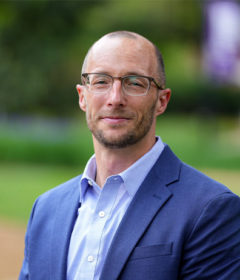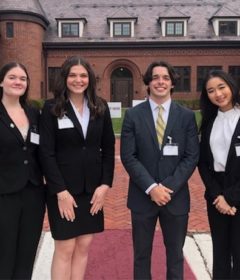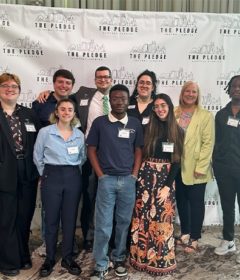Raising the Volume
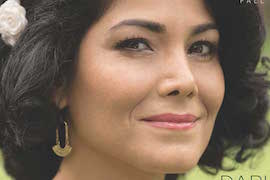
For lack of a suitably precise subject, call this “a look at complex global issues through an uncommon lens.” Or simply label it “Asal Mohamadi Johnson.”
Which best describes the subject matter?
- Human rights
- International studies
- Diversity and inclusion
- Social injustice
- Public health
- Urban planning
- All of the above
Which best describes the leading character?
- Broad-minded
- Resolute
- Daring
- Atypical
- Curious
- Transformative
- All of the above
Indeed, Asal Mohamadi Johnson, Ph.D., is all of the above. What’s more, as an assistant professor of public health, her platform at Stetson puts her in position to make a difference, both on campus in DeLand, Fla., and across the world.
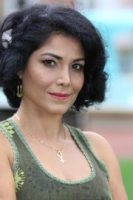
Transformational difference? Hyperbole aside, just maybe.
Also just maybe, the light wouldn’t be shining on Johnson so brightly this fall without her research “The Effects of Residential Segregation and Neighborhood Characteristics on Surgery and Survival in Patients with Early-Stage Non-Small Cell Lung Cancer,” which captured academic and media attention last spring. Johnson was the lead author, and the research was selected for publication in Cancer Epidemiology, Biomarkers & Prevention , a journal of the American Association for Cancer Research.
Funded by a Stetson faculty-development grant, the research continued an important conversation.
In essence, the research focused on non-small cell lung cancer (NSCLC), the most common type of lung cancer. If caught at an early stage, the disease can sometimes be cured by surgical resection. Previous research had documented disparities in the rate of receipt of NSCLC surgery and in survival. Johnson went further, finding that black residents of highly segregated neighborhoods were less likely to receive surgery for early-stage NSCLC than their peers in less-segregated neighborhoods.
“Instead of solely looking at health disparities between white and black patients,” Johnson explains, “our study focused on differences in survival among black patients resulting from different levels of neighborhood segregation.
“At least half of patients diagnosed at early stages who undergo surgical treatment survive more than five years, whereas, without surgery, most will die within a year.”
Clearly, the research is important, providing new insight into an area that warrants greater scrutiny. Even more, it is quintessential Johnson. She was concerned and inquisitive, so she dug deeper for answers.
“I’m very much curious to ask questions,” she asserts, “and then go find the answers.”
Johnson advanced the conversation while also acknowledging that further study surrounding segregation is necessary. “This is an ongoing conversation that should continue until something actually happens,” comments Johnson, who concedes to continually working on research projects since 2010 even when on vacation.
In typical fashion, she raised the volume. And, at a time when Stetson is putting diversity and inclusion squarely under its own microscope as part of mounting “Many Voices, One Stetson” momentum in the quest to initiate discussion of difficult social issues, Johnson’s substance and style couldn’t have come at a better time.
Johnson has never been one to sit idly as the world goes by, not growing up in Iran or teaching in DeLand. She not only opens envelopes but stretches them. She explores and implores.
Now, at Stetson, she simply asks that her students do the same. With such examination needed globally — and welcomed on campus with arms extended wide — Johnson is taking a lead role.
“Put yourself in my shoes,” she tells her students with her Persian accent, in this instance regarding human rights. “… If I came to this conclusion being raised in Iran, you can come somehow to this conclusion — you live in the United States.”

Raised in Tehran, the capital of the Islamic Republic of Iran, Johnson had plenty of opportunities to look away. She was born at the time of the Islamic revolution and the arrival of the Ayatollah Ruhollah Khomeini. Years of uneasiness and uncertainty ensued.
Her parents were caring, disciplined and determined. Neither had the benefit of higher education, but they labored to ensure a better life for their five children. Johnson was one of four daughters. While others were having fun, they studied and read, particularly Johnson. Notably, all siblings attended college and remain in Iran.
“I read books [mostly philosophy and world literature] that were not appropriate for my age, but they were good books. It kind of defined me as who I am,” she recounts, adding that Iranian girls do have educational opportunities but also must endure ongoing injustices.
Her journey to America was similarly challenging and fruitful.
Obtaining a bachelor’s degree in economics and a master’s in urban planning in Iran, she received a Ph.D. in urban planning from Florida State University, but not without hurdles. Because there wasn’t a U.S. Embassy in Iran, Johnson traveled to Cyprus to obtain a visa and was initially rejected. Successful application required proof of financial aid from a U.S. university; she didn’t have it. So, she immediately found internet access at a coffee shop in Cyprus and emailed FSU to state her case. She eventually received the aid.
Subsequently, against the advice of friends, who thought she was wasting time and money, she reapplied for a visa and was approved. She began attending FSU in 2006.
With a doctorate in hand and a year of teaching under her belt, she then landed at Georgia Southern University, where she received a master’s in public health (epidemiology) and taught courses in sustainable development, statistics, international studies and global health. Finally, she found her way to Stetson in 2014.
She arrived with her husband, Allen Johnson, Ph.D., a native of Charleston, S.C., and now a professor at Rollins College, whom she had met at FSU (partly by virtue of their mutual interest in public health). Also, Johnson brought passion strengthened by a trying path.
“If you are consistent and persistent,” she asserts, “I don’t think there’s anything that’s impossible in this world.
“There have been barriers, but I’ve never given up. Persistence has always gotten me the result I wanted.”
At Stetson, that conviction became lesson No. 1.
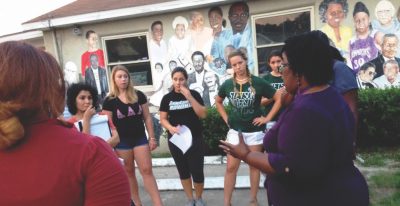
By that time, Johnson had merged her academic training in urban planning and public health to address global issues across a spectrum that encompasses everything from socioeconomics and healthy neighborhood development to human rights, race and ethnicity, religion, apartheid, and sexual orientation, among others. She employs a multilayered approach to understanding the connections among health, the built environment and social justice.
Regardless of topic — maddening, messy, controversial or contradictory – she presses her students to assess and question, even when instincts suggest otherwise.
“Maybe they don’t want to think about those topics voluntarily,” she says. “But I put them out there. I have them do research and come to class ready to discuss the problem. I tell them that you might be really out of your comfort zone, but that’s why you’re here.
“I tell them I know you’re uncomfortable and you don’t have to come up with answers right away. But keep this in the back of your mind that this is a problem and our world needs to come up with an answer.”
It’s all part of raising the volume.
Johnson’s “Effects of Residential Segregation” is one example. For the record, she advocates urban planning and public-policy efforts to encourage a shift to more racially and economically mixed neighborhoods. “It’s not very healthy for people to live in racially isolated areas when they do not have access to job opportunities, transportation options and many other resources,” she says.
Her work with Spring Hill, a community just minutes from campus, is another example.
Spring Hill, a 4-square-mile area, is largely considered one of the lowest-income communities in Florida. Johnson and a class of students went to see for themselves, assessing public-health needs and attending community events. She called the students’ fieldwork a “transformative experience,” one that cut to the very core of diversity and inclusion.
Johnson isn’t looking to change the world. She’s not even certain of being thought of as a leader, noting, “I don’t know if I’m there yet, but I would like to be.”
By teaching students, though, she is hoping to make a difference, to prompt some sort of change or at least to initiate discussion. “You can always hope that some time in the future something will happen in their life experience that will remind them of their class experience,” she says.
A transformative impact? Johnson isn’t ready to be graded on that question. She shakes her head and flashes a broad smile.
“Right now, I do not know that,” she concludes, “but I am hoping to work toward that direction.”
-By Michael Candelaria
Note: This article originally appeared in the Fall 2016 issue of Stetson University Magazine. To read the entire magazine, click here. The next issue of the magazine is scheduled for publication this winter.

